Isofix Seats
Car seats, seat belts, and seat belt anchorages vary dramatically between cars. Car seats have different shapes; some seat belts are shorter than others, and some anchor points are further forward or have shorter stalks than others. All this makes it tricky to fit a child car seat correctly, and surveys consistently find that a high proportion of child car seats are fitted incorrectly.
Isofix provides a more secure and easier way of attaching child seats in cars.
Basically, fitting points are built into both cars and child car seats when they are manufactured. An Isofix child seat is 'plugged' into the corresponding fitting points in the car, removing the need to use the car's seat belts to secure it. An additional top tether or support leg is used to prevent the child seat titling or rotating in an impact.
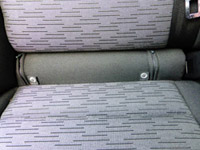
Isofix has been a legal requirement on all new cars sold in the EU since 2014, but you'll also find the mounting points on many older cars. To find out if your car has Isofix points, look for Isofix labels between the base and back of your car seats (the fitting points themselves may also be visible) or check your vehicle's handbook or contact the manufacturer or dealer.
To find out if your Isofix child seat is approved for your vehicle, check with the child seat manufacturer or retailer; many have a list on their website that shows which seats are approved for which cars. Your car manufacturer may also be able to tell you which Isofix child seats fit your car.
When buying a new Isofix child seat, take your car to the retailer, if possible, and ask to try the seat out in the car before you buy it.
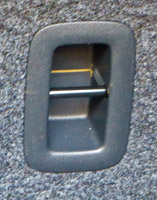
Top tether
A top tether is a fabric strap that secures the child seat to a tether point behind the rear car seat, usually at the back of the rear seat, the bottom of the trunk or on the ceiling. Check your car's handbook for the exact location in your car. Top tethers on rearward-facing car seats often have to be attached to the car's front seat.
Any Isofix child seat with a top tether should fit any car with a top tether anchor point, but check compatibility with the vehicle(s) you use before purchasing.
Support leg
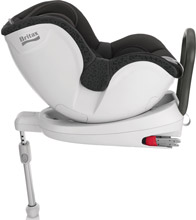
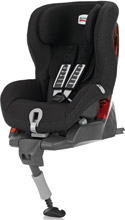
A support leg is fitted to the child seat and extended to the floor of the car between the back seat and the front seat, or between the front seat and dashboard. It prevents the child seat tipping over forwards in a collision. They are easier to use than a top tether. However, if there are hollow storage compartments in the floor, the foot of the support leg must not rest on the lid of the compartment because it may collapse under the forces created in a collision.
Rearward-facing seats may also have a brace that goes against the back of the car's front seat.
Fitting Isofix child seats
- Check that your Isofix seat is approved for use in your particular vehicle. Isofix seats will not fit in every car with Isofix points.
- As with any child car seat, follow the manufacturer's instructions carefully.
- For advice on choosing a compatible car seat and installing it in your vehicle, visit our Child Car Seat Fitting and Compatibility page
- Some isofix cars have Isofix slots hidden behind the rear seats, in the joint between the back of the seat and the seat cushion, whereas on some isofix vehicles, the points are more visible. Some cars have a third Isofix attachment point, for a top tether, behind the rear seat to stop the child seat tipping forward in a collision.
- Locate the Isofix points in your car by checking your car's handbook and looking for the Isofix label on the rear seats.
- Locate the Isofix connectors (two prongs sticking out of the back) on the child seat or base.
- Push the connectors into the Isofix slots in the car seat. There will be an audible click on many child seats, and/or a visible indicator that turns from red to green, to show that the child seat has been securely attached.
- If using the top tether fixing point, connect the top tether strap to the top tether point in the car. Some have a visible indicator that turns green when they are set correctly. Do not attach it to anything else, such as a head restraint or luggage hook as they will not be strong enough.
- If using a child seat with a supporting leg, make sure that the leg is correctly adjusted so the seat is braced against the floor. Some have a visible indicator that turns green when they are set correctly. Make sure the leg is not sitting over an underfloor storage compartment because this may collapse from the force of an impact coming through the support foot.
Isofix Booster seats
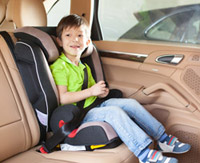 Isofix connectors fix the booster seat into the car in the same way as above, but both the child and seat are also held in place by the adult seatbelt.
Isofix connectors fix the booster seat into the car in the same way as above, but both the child and seat are also held in place by the adult seatbelt.- Thread the seat belt through the red guides or slots. There is usually one at shoulder height to position the diagonal part of the seat belt and ones at waist height, often under the booster seat's armrests, to help position the lap part of the seat belt.
- The seat belt should go across the child's pelvis, chest and shoulder:
- the belt should be worn as tight as possible
- the lap belt should go over the pelvic region, not the stomach
- the diagonal strap should rest over the shoulder, not the neck
- If the seat has an adjustable back or adjustable head rest, raise or lower this to suit the height of the child using it.
Photos courtesy of Britax and RECARO Child Safety Ltd
